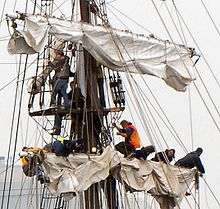Rah


The Rah (also Raa or Rahe) is a part of the rigging of a sailing ship that carries the sails .
function
Yards are round poles , usually made of wood or steel, with both ends (cams) protruding from the mast, in contrast to trees, gaffs and sprites, which are attached to the mast at one end. The best-known forms of sails on yards are latin sails, lug sails and the typical symmetrical cross sails generally known as square sails. With these, the yard is fastened with its center horizontally across the direction of travel to a rack on the front of the mast, which enables a rotating movement ( bream ) and a vertical movement ( topping ). The ends of the yard are called Rahnocken and take on the running goods for setting sails and moving the yard with slings and rollers .
A yard is rotated around the mast ( "blown" ) until the square sail is optimally positioned to the wind direction and generates maximum propulsion . In a broader sense, bream means taking into account that the wind flow decreases near the surface of the water, so that the optimal alignment of yards lying on top of each other results in a slightly offset spiral arrangement. To reef , pack or unpack the sail, a sufficient number of people ( top guests ) stand on the foot peg , a rope that is hung from the yard at regular intervals, lean on their stomach over the yard and are secured by appropriately shaped shoe heels and snap hooks . The salvaged (unfolded) sail is tied under the yard. This work requires the greatest amount of muscle on the cams of the yard.
There are also pods for the square sail ; In contrast to jib sails , the sheets on the square sail are an additional help for setting the sail and pull the lower corners of the sail (clews) to the yard below. Only the sheets of the lowest sails are led to the deck and must be used when breaming. Other ropes of this type of sail are geitau and gordinge , with which the sails are pulled up (gathered) to the yard from the deck. The vultures pull the clews up while the gordinge (not available on all square sails) pull the cloth together.
While in the Middle Ages, square sails were more widespread in northern regions, so-called Latin rigging with scraper sails developed in the Mediterranean and the Arab regions . With the scientific processing of sailing technology, the sensible combination of the two principles went hand in hand. Examples of mixed forms of rigging are Rahschoner , Brigantine and Schebecke .
The yards of historical tall ships could be more than twice the width of the ship's hull. The four-masted clipper Great Republic is reported to be 36.8 meters long and the Eagle of Lübeck 34.2 meters. The higher-lying yards are kept shorter for reasons of statics . Some tall ships were able to lengthen some yards with retractable leeward spars and attach leeward sails there in order to better exploit weak winds.